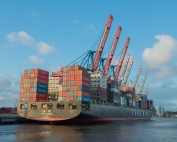Did you know that 70% of U.S. duty drawback refunds remain unclaimed & are ultimately lost?
In the current environment of ever-changing tariffs and trade deals, duty drawback has become an essential means of duty mitigation and supply chain cost management for thousands of companies across the U.S. As two of the oldest duty drawback specialist organizations in the country, Comstock & Theakston, Inc. (Comstock) and C.J. Holt & Co., Inc. (Holt) combine to provide a comprehensive and universal approach across multiple industries delivering a higher standard of customer service to navigate the intricacies of the drawback process. We are the only U.S. drawback specialist with 14 licensed Customs Brokers and can provide you with the assistance necessary to attain the largest potential duty drawback refund possible through customized and innovative solutions.
What is Duty Drawback?
Duty drawback is the refund of duties, taxes, and fees paid on imported merchandise that is exported or used in the manufacturing of exported merchandise. The establishment of the U.S. duty drawback program and the legislative policy underlying the program is to ensure the competitiveness of U.S. industry in the global market when competing against lower-priced products from our trading partners.
In most situations, U.S. Customs will refund up to 99% of the original duties and fees paid by the importer and will allow the claimant to reach back and claim drawback on export transactions that are a maximum of three years old. You need not be the importer or even the exporter in order to receive a duty drawback refund. Rights to drawback dollars can be assigned to or from importers, exporters, or other parties in the supply chain.
The drawback process is not simple, but that’s where we come in! As your drawback specialist, we will work with you to identify your potential and the drawback types you can pursue, create a customized drawback program, and communicate with U.S. Customs regarding your claims.
Are You Eligible for Duty Drawback?
The drawback program was initiated for the purpose of creating jobs, encouraging manufacturing, and increasing exports. The Continental Congress first established drawback in 1789, and it was initially limited to specific articles that were directly imported and exported. Since that time, drawback has been expanded to include numerous products and industries, including:
- Agricultural products
- Alcohol and beverages
- Automotive
- Consumer goods
- Industrial chemicals
- Metals and alloys
- Petroleum and derivatives
- Petrochemicals
- Pharmaceuticals and medical equipment
- Piece goods/fabrics
- Wearing apparel
Although there are several types of duty drawback available, the programs most commonly utilized by the importing and exporting trade community are unused merchandise, manufacturing, and rejected merchandise.
FEATURED POST
Section 301 Tariff Pain? Drawback Can Provide Relief
We are receiving daily calls from companies who are encountering additional tariffs that have been assessed on specific products from China. Some of these companies were not previously paying any duties and are now estimating millions will be paid if these tariffs remain active.


